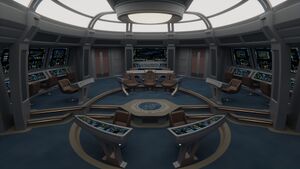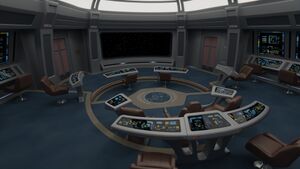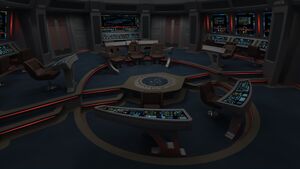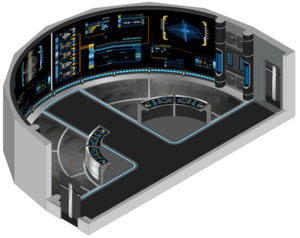USS Hathaway
- "Be fearless in the pursuit of what sets your soul on fire."
- —Jennifer Lee - Ship's Dedication Quote
Fourth in the lineage of vessels to bear the name, the USS Proxima NCC-75503 (Sovereign-class) is a highly versatile exploration vessel widely considered to be one of the most advanced starships in the service of the Federation. The immediate successor to the Nebula-class USS Proxima lost during exploration operations in the Gamma Quadrant, the current iteration has served for some fifteen years and is currently assigned to Task Force 17 under the command of Captain Vasoch Gor.
Looking to make a name for themselves in the annals of history, the crew are fresh from a number of more mundane activities at the turn of the century and have now embarked upon a new mission of exploration, with the ship currently operating out of Deep Space 17 in the Typhon Frontier, an area ripe for scientific exploration.
Mission Objectives
A multi-purpose starship well into its second decade of service, Proxima has completed a wide variety of tasks and missions assigned to it over the years. Some of its core duties, commensurate with the Sovereign-class as a whole, include:
- Performing a wide range of duties linked to research projects both scientific and explorative in nature.
- Replacing ageing starships as the primary instrument of Federation deep-space defence and along all borders.
- Operating autonomously under the command of the commanding officer, providing the full capability to execute Federation defensive, cultural, scientific, and explorative policy in deep space or along border territories.
- Providing frontline support during times of war or crisis, such as the Century Storm and Blood Dilithium situations.
- Functioning as a mobile platform for the testing and implementation of new technologies, as mandated by Starfleet Command, above and beyond mission-specific parameters.
Into the Expanse
2400 - The 25th Century Awaits
After an arduous fourteen years of service under four different commanding officers, Starfleet finally deemed it necessary to bring the Proxima up to modern standards. In mid-2400, Proxima arrived at Starbase Bravo to undergo a six-month overhaul, during which her commanding officer would be reassigned. Upon the refit's completion, the internal structure of the ship, and many of her systems, had been significantly updated. There had been several new additions, too, with holo communications, three-dimensional displays in different locations, a brand new Strategic Operations suite (StratOps) and an entirely new bridge module, the first of its design in service.
2401 - Into the Expanse
With her refit complete, a skeleton crew transferred Proxima to Deep Space 17, where a new commanding officer was appointed by CAPT Romaes Anjin, TFXO for TF17. After a hiatus which saw him take leave on multiple worlds, a chance encounter saw the Tellarite, Vasoch Gor, re-evaluate his choice to leave Starfleet. Negotiations with Romaes saw the man rewarded for his years of dedication and experience with his first permanent command aboard Proxima. With a new executive officer under his command, Gor began the task of forming a new command team for the ship.
Commanding Officer Lineage
In the time since her construction, and prior to the assignment of Captain Gor, Proxima has been privileged to have three commanding officers overseeing her tours of duty, and one Captain of Engineering overseeing her construction.
- 2386 - 2389: Captain Nilani Azulas, (Trill Female)
- 2389 - 2390: Captain Mitchell Hanson, (Human Male)
- 2390 - 2395: Captain Colby Drayton, (Human Male)
- 2395 - 2401: Captain Leandra Nunez, (Human Female)
- 2401 - Present: Captain Vasoch Gor, (Tellarite Male)
Technical Configuration
Main Article: Sovereign-class Explorer
Placed on the drawing board of the Advanced Starship Design Bureau (ASDB) after the Borg incursion of 2366, the Sovereign-class Project was one of three proposed starship designs to take advantage of new defensive technologies initially intended for use against the Borg. Initial production of the class began at Utopia Planitia on Mars, with the construction of new ships moving to the San Francisco Fleet Yards, Earth (among others) following the Synth attack on Mars in 2385. Proxima, along with ships such as Venture, was one of the first of her class to be constructed after the tragedy on Mars, and carries a dedication plaque to the memory of all involved in Sovereign production who were lost in the attack. While her external framework remained the same, her internal design and systems have been significantly adapted over the years.
Heavily armed from the beginning, it is easy to see that the design philosophy for the class, originally shaped by the discovery of the Borg, has been influenced by the changing times and threats that have emerged in the decades since. Proxima utilises some of the most up-to-date technologies available. Every ship in her class to date has pushed the envelope as far as possible when it comes to computer power, her shield grid, armaments and other systems capabilities, but Proxima continues to push the boundaries further. She combines all of the creature comforts associated with the larger Galaxy-class vessels with the tactical power of vessels such as the Prometheus and Inquiry class starships, whilst harnessing technological improvements such as holographic communications and three-dimensional computer displays - although these are limited to engineering, sickbay and the science facilities at present.
Eight rapid-fire torpedo launchers - mounted in a configuration of three forward and five aft - are coupled with a single forward rapid-fire turret mounted on the ventral saucer section. With an incredible firing arc and the capability of variable-geometry fire, the turret is capable of firing torpedoes quickly enough to turn the entire forward arc of the ship into a kill zone. Accompanying her impressive torpedo complement, sixteen of the most powerful phaser arrays to be installed aboard a Federation Starship to date ensure Proxima is capable of delivering crippling blows to enemy shields and armor when required. But as ever, discretion is always the better part of valor.
Drawing upon a sophisticated warp drive, Proxima can match ships such as the Prometheus, Inquiry and even Intrepid-class for top speed, but her cruising speed is reduced due to her size and hull geometry. At impulse speeds, her impulse engines are unparalleled when it comes to their raw ability to accelerate and turn a massive starship, meaning she is deceptively agile in combat. This superb performance comes at a cost; her engineering team requires many specialists in their respective fields to keep her systems functioning at peak performance, meaning engineers make up a large proportion of the personnel manifest.
As one of the fleet’s premier explorers, Proxima enjoys state-of-the-art resources and facilities dedicated for exploration and scientific research purposes for every scientific discipline operating aboard ship, making the ship less of a specialist research or exploration vessel and more of a general all-rounder. She does boast an impressive sensor suite capable of analysing most nebulae and performing micrometre-scale orbital scans, and which has also proven to be more than a match for most older cloaking devices.
In contrast to her brief as a deep space explorer, it is a surprise to note the lack of dedicated facilities for diplomatic functions compared to other dedicated diplomatic platforms such as the Obena and Odyssey classes. Proxima has only three VIP staterooms, albeit luxurious and spacious ones, but these facilities are located away from the main lounge and holodecks which would normally play host to diplomatic gatherings. Her tactical capabilities and status as the closest thing to a Federation battleship might not fit the profile of a diplomatic cruiser, but it is those very capabilities that mean Proxima is more than ideal for transporting dignitaries through potentially hostile territories or to tense negotiations.
Although not as spacious as some of her contemporaries, and even successors such as the Odyssey-class, Proxima would still be considered a very comfortable posting among fleet personnel, with competition for postings high and applications usually numbering in the hundreds for every vacancy. For those lucky enough to serve, a wide variety of housing arrangements provide her crew with ample opportunities to integrate, whilst senior officers benefit from staterooms and spacious suites as rank dictates. Access to a range of shipboard amenities allows the crew to eat, socialise and unwind however they see fit, with holodecks, mess facilities, a theatre, an auditorium, gymnasiums and arboretums among facilities available to all.
Key Location Data
- Main Article: Proxima deck listing
- Main Article: Tour of the Proxima
With 24 decks, the ship has hundreds of rooms and locations that serve a variety of purposes for the crew. Some of the more notable locations include:
Bridge
Consisting of an amalgamation of successful features from both the Galaxy and Sovereign lineages, Proxima has one of the more unique bridge modules in the fleet. Importantly, it makes the most of a variety of technological advancements, such as holoprojectors, holographic communications, in-built weapons lockers and three-dimensional computer displays wherever possible.
A unique design feature of the Proxima bridge module is the desire to have as many stations as possible facing a single focal point at the heart of the command center. This focal point is the United Federation of Planets logo proudly displayed on the carpeted deck plating, but this is not for purely decorative reasons. The logo actually serves as a holo-communications platform at the center of the bridge, capable of displaying holoprojections of people lightyears away. Surrounding the holo-platform is the standard tri-seat command pit, with seats for the Captain, Executive Officer (starboard) and a third seat (port), reserved for the use of the ship's Counsellor, Chief Medical Officer or any official or dignitary the Captain sees fit to permit on the bridge. Each seat has independent computer controls allowing access to a wide variety of ship systems.
Directly port and starboard of the command chairs are the inward-facing duty stations for tactical operations (port) and science (starboard). On the perimeter of the bridge there are countless other additional stations designed to support mission operations. Behind the main science station on the starboard bulkhead, additional science and medical consoles are available, as well as access to life support. Adjacent to them on the starboard bulkhead, strategic operations, intelligence and security deployment stations are the focus. Directly behind the command chairs is a large console entirely configurable for the needs of any department, but with dedicated access to engineering functions if required, allowing the Chief Engineer (or any assigned officer) unparalleled access to engineering systems outside of the engineering bay itself. On the aft bulkhead, the obligatory Master Systems Display (MSD) is present, but this is a fully customisable display, capable of hundreds of functions, including operating as a reduced viewscreen for mission operations.
Directly ahead of the command pit, at the bottom of the ramp and between the commanding officer and the holographic viewscreen, two curved consoles serve as duty stations for Operations (port) and Flight Operations (starboard).
Around the command center, four doors provide access to and from the bridge. On the forward port bulkhead, access is available to the commanding officer's ready room, and adjacent to it, the observation lounge and strategic operations suite. Aft of the bridge, both doors provide access to turbo lifts which enable the crew to access the command center from the rest of the bridge. Either may be overridden for priority access to key locations around the ship.
Most notably, and a further move away from more recent trends, the bridge module is very well-lit, with the colours and tones in the room complimenting each other nicely and creating a warm aesthetic that is pleasing on the eye. During red alert, however, the bridge lights are dimmed and largely replaced by dozens of strip lights (visible along the floor and walls) that flash five times at the initial call for red alert, and then remain stationary until the alert is cancelled.
Strategic Operations Suite or StratOps, Deck 1
Accessible from the bridge, the new Strategic Operations suite (known colloquially as StratOps) is an exciting new addition designed to enhance the strategic capabilities of Proxima during longer-term missions and large-scale engagements. Facilities in this room allow the crew to deal with any scenario that may arise in their mission, without the need to access more specialised facilities around the ship unless absolutely necessary or appropriate. Missions are routinely monitored here, and additional personnel from across the ship may be assigned on a needs basis, such as additional medical or science personnel when evacuating a colony or dealing with an anomaly; security may be beefed up from here in the event of a tactical scenario such as an intruder alert or boarding action; intelligence, strategic operations and command analysts are likely to use the space to provide relevant departments with up to date information in ever-changing scenarios. Interestingly, it is the preference of Captain Gor to hold senior staff briefings in the StratOps suite, with the lack of chairs allowing for a more fluid dynamic in the room where anyone can access the consoles, move around, discuss and form ideas.
Auxiliary Craft
- Main Article: Auxiliary craft deployment aboard Proxima
As a Sovereign-class starship with two shuttlebays (one much larger than the other), Proxima is capable of housing a large contingent of auxiliary craft. The deployment and organisation of such craft has always been at the discretion of the commanding officer, and as such, Captain Gor has used Proxima's mission profile to reduce the number of personnel shuttles and runabouts to make room for a squadron of Valkyrie-class Starfighters in the lower shuttlebay. Codenamed the Black Knights, this small squadron is capable of conducting a range of operations in support of Proxima's main mission objectives.



